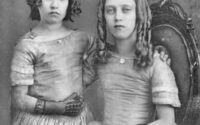The Man Behind the Mask: Charles Dickens’s Cruelty to the Wife Who Gave Him 10 Children .m
Charles Dickens is celebrated as a great champion of social justice, but his family legacy hides a dark secret: the brutal treatment of his wife, Catherine Hogarth, who sacrificed her youth and health to his career. This is the story of how the literary genius built a brick wall to “erase” his wife.
The world knows Charles Dickens as a genius, a voice for the oppressed, a man who wrote compassionate masterpieces about poverty and injustice. But at home, he was the oppressor himself. The story of his marriage to Catherine Hogarth is a wake-up call to the horrifying difference between his public image and his private life.
Sacrifice and the cruel response
Catherine Hogarth married Dickens in 1836, when she was just 21. Over the next 16 years, she endured 10 pregnancies, gave birth to 10 children, and buried three of them while they were still young. While Catherine shouldered the responsibility of raising the surviving children and managing the increasingly busy social life of a famous writer, Dickens demanded that she be the model of the perfect Victorian wife.
But as her body suffered—the weight gained after ten births, exhaustion slowed her, grief made her withdrawn—Dickens turned away.
He called her unfit, lazy, jealous, and boring. He told friends that she was mentally unstable, blaming her for everything bad in his life. She wasn’t lazy; she was exhausted by the burden of her husband’s family and career. She wasn’t boring; she was mourning her lost children.
The Brick Wall and the Forbidden Love
The cruelest turn of events came when Dickens, 45, fell in love with the 18-year-old actress Ellen Ternan.
Since Victorian England law made divorce almost impossible without a career-destroying scandal, Dickens took a more brutal approach: he decided to “erase” his wife.
In 1858, after 22 years of marriage, he banished Catherine from his home. He built a brick wall across the door connecting their bedroom—a physical wall that mirrored the broken emotional wall.
But that wasn’t cruel enough.
The Violated Letter: Public Ruin
To clean up his public image, Dickens published a letter, known as “The Violated Letter,” in which he portrayed himself as the victim of a troubled marriage. He made his private suffering public, painting Catherine as the troublemaker and himself as noble and enduring.
The Victorian public, who revered this great humanitarian, believed him. Catherine lost everything: her home, her social standing, and most painfully, her children—all but one of whom sided with their famous father. Even her own sister, Georgina, chose to stay with Dickens to help him raise Catherine’s children.
Catherine spent the rest of her life in silence, preserving her dignity. She was a survivor who had endured what would have broken anyone.
Hidden Legacy: The Truth About the Love Letters
Before her death in 1879, Catherine had only one wish: to publish the love letters Dickens had written to her when they were lovers, when he was poor and she meant everything to him. She wanted proof that he had loved her.
That request was denied. It wasn’t until 1935, 56 years after her death, that the letters were published.
By then, Dickens had been dead for 65 years, his literary genius assured, and his personal cruelty largely forgotten or excused.
What we need to remember is this: Charles Dickens wrote brilliantly about injustice. But he couldn’t—or didn’t want to—recognize the injustice he did to the woman who gave him a family and supported him on his way to fame.
The next time you read Dickens and marvel at his compassion for the poor, remember Catherine. Remember that sometimes the people most blind to injustice write about it most beautifully.


